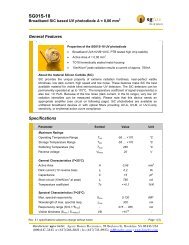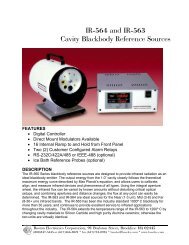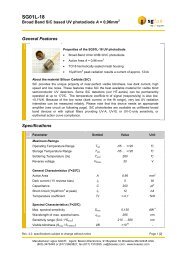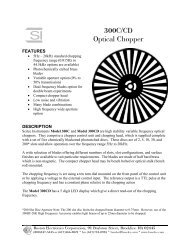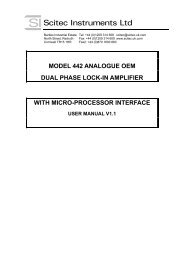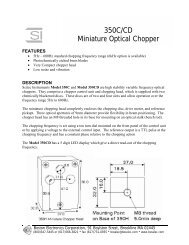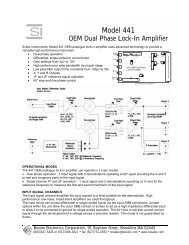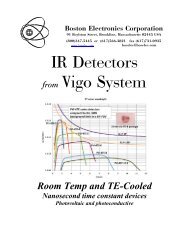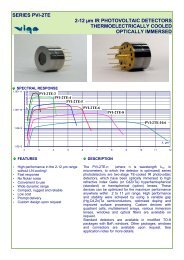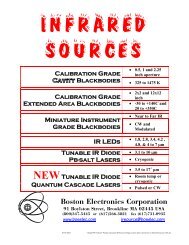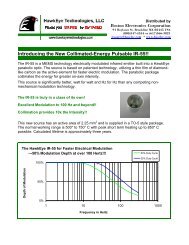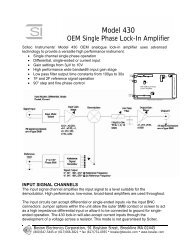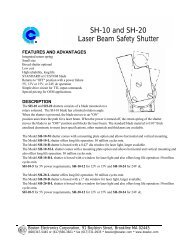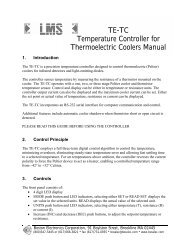TCSPC for FLIM and FRET in - Boston Electronics Corporation
TCSPC for FLIM and FRET in - Boston Electronics Corporation
TCSPC for FLIM and FRET in - Boston Electronics Corporation
Create successful ePaper yourself
Turn your PDF publications into a flip-book with our unique Google optimized e-Paper software.
<strong>TCSPC</strong> Imag<strong>in</strong>g<strong>TCSPC</strong> Imag<strong>in</strong>g is an advanced <strong>TCSPC</strong> technique used <strong>in</strong> conjunction with scann<strong>in</strong>g microscopes.The method builds up a three-dimensional histogram of the photon number over the time <strong>and</strong> thecoord<strong>in</strong>ates of the scan area. The pr<strong>in</strong>ciple is shown <strong>in</strong> figure 30. The record<strong>in</strong>g electronics consistsof a time measurement channel, a scann<strong>in</strong>g <strong>in</strong>terface, <strong>and</strong> a large histogram memory.The time measurement channel conta<strong>in</strong>s the usual <strong>TCSPC</strong> build<strong>in</strong>g blocks. Two constant fractiondiscrim<strong>in</strong>ators, CFD, receive the s<strong>in</strong>gle photon pulses from the detector <strong>and</strong> the reference pulsesfrom the laser. The time-to-amplitude converter, TAC, measures the time from the detection of aphoton to the next laser pulse. This ‘reversed start-stop‘ pr<strong>in</strong>ciple is the key to the process<strong>in</strong>g ofhigh laser repetition rates. The analog-digital converter, ADC, converts the TAC output voltage <strong>in</strong>toan address <strong>for</strong> the memory.DetectorTim<strong>in</strong>gStartStopfrom LaserTimeMeasurementCFDTAC ADCCFDtTime with<strong>in</strong> decay curveFrame SyncL<strong>in</strong>e SyncPixel ClockfromMicroscopeCounter YScann<strong>in</strong>gInterfaceCounter XyHistogramMemoryxLocation with<strong>in</strong> scann<strong>in</strong>g areaFig. 30: <strong>TCSPC</strong> Imag<strong>in</strong>gThe scann<strong>in</strong>g <strong>in</strong>terface is a system of counters. It receives the scan control pulses from themicroscope <strong>and</strong> determ<strong>in</strong>es the current position of the laser beam <strong>in</strong> the scann<strong>in</strong>g area.When a photon is detected the device determ<strong>in</strong>es the time, t, with<strong>in</strong> the fluorescence decay curve<strong>and</strong> the location of the laser spot with<strong>in</strong> the scann<strong>in</strong>g area, x, y. These values are used to address thehistogram memory. Consequently, <strong>in</strong> the memory the photon distribution versus t, x, <strong>and</strong> y buildsup. The result can be <strong>in</strong>terpreted as a stack of images <strong>for</strong> different times after the excitation pulse oras an array of pixels conta<strong>in</strong><strong>in</strong>g a complete fluorescence decay function each.The implementation of <strong>TCSPC</strong> imag<strong>in</strong>g <strong>in</strong>to Zeiss microscopes is described <strong>in</strong> [67-69]. Thedescribed <strong>in</strong>strument consist of a Zeiss LSM-510 NLO Laser scann<strong>in</strong>g microscope, a femtosecondTi:Sa laser, a fast PMT, <strong>and</strong> a Becker & Hickl SPC-730 <strong>TCSPC</strong> imag<strong>in</strong>g module [63]. The setup isshown <strong>in</strong> fig. 31.27



